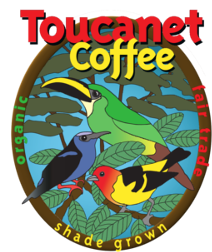I talk about birds in coffee a lot on this site– how birds use and need the resources provided in shade coffee farms is the inspiration for the site. How about birds on coffee…labels and logos?
First up, coffee roasting companies named after birds.
 Caffe Ibis – White Ibis
Caffe Ibis – White Ibis
Toucanet Coffee – Three birds: an Emerald Toucanet, Red-legged Honeycreeper, (both tropical species) and Western Tanager (breeds in North America, winters in the tropics).
And here’s a sampling of birds on coffee packaging.
Thanksgiving Coffee Company – Songbird Coffee series in partnership with the American Birding Association. Top = Wilson’s Warbler, Black-throated Green Warbler, and Indigo Bunting; Bottom = Ovenbird, American Redstart, and Baltimore Oriole. All North American breeding birds that winter in the tropics.
Thanksgiving Coffee Company – More partnership coffees. Common Yellowthroat on Birder’s Blend (Wild Birds Unlimited); Broad-winged Hawk on Broadwing Blend (Hawk Mountain Sanctuary); Cerulean Warbler on Conservation Coffee (American Bird Conservancy); and Ruby-throated Hummingbird on Trust for Wildlife. All North American breeding birds that winter in the tropics.
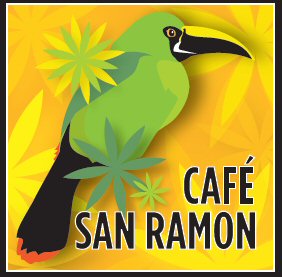
Counter Culture Coffee,Café San Ramon — Emerald Toucanet, a tropical species. I have to say, this is my personal favorite because Counter Culture asked me to help them identify an appropriate species for this product and this was one of the first choices. Plus, I’ve actually seen this species on the very farm that is the main source of this coffee.
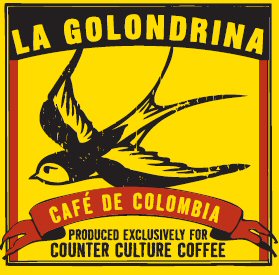
Counter Culture Coffee, La Golondrina – a swallow. There are many swallow species, both resident and migrants to the tropics. According to Counter Culture, a swallow was chosen as in Latin American culture, the swallow is a symbol of communication between people separated by distance and borders.
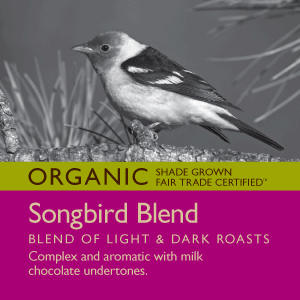
Tony’s Coffee and Teas, Songbird Blend. Another Western Tanager.
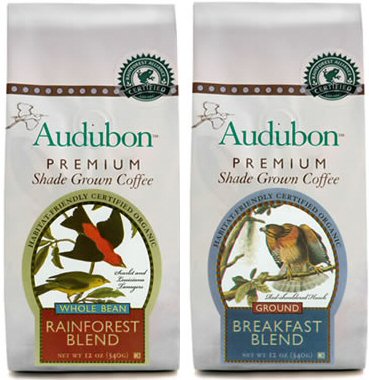
Audubon Coffee, Rainforest Blend and Breakfast Blend. Scarlet Tanager and Broad-winged Hawk. Both North American breeders that winter in the tropics. These are both portions of paintings by John James Audubon.

Golden Valley Farms has nearly a dozen Smithsonian Bird-Friendly certified coffees featuring birds on the packaging. Here are just three. The El Salvador Santa Teresa Bourbon has a Rose-breasted Grosbeak, which breeds in North America, winters in the tropics. The Red Knot blend shows a shorebird of the same name, which makes one of the longest migrations of any bird, from the Arctic to Tierra del Fuego. This coffee raises funds for this species, which has experienced dramatic population declines. Finally, their Ethiopian Lekempti has a hornbill on the package, probably a Silvery-cheeked Hornbill. These striking large birds nest in cavities, and they restrict the entrance to their nest holes with mud, droppings, and fruit pulp. The female becomes sealed inside while incubating eggs and tending to young, with the male passing food through a small hole. The female breaks out when the nest hole gets too crowded.
Know some other roasters or coffees with a cool bird as a logo? Let me know in the comments!


